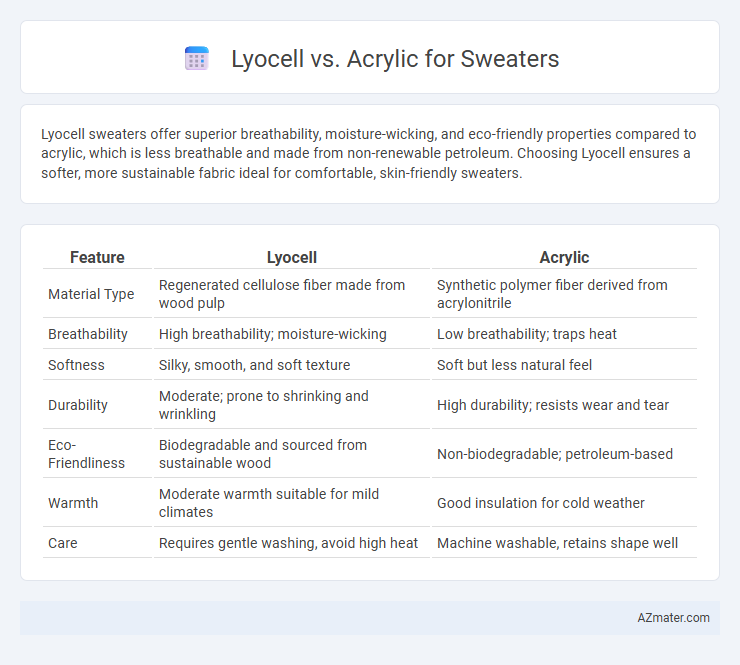Lyocell sweaters offer superior breathability, moisture-wicking, and eco-friendly properties compared to acrylic, which is less breathable and made from non-renewable petroleum. Choosing Lyocell ensures a softer, more sustainable fabric ideal for comfortable, skin-friendly sweaters.
Table of Comparison
| Feature | Lyocell | Acrylic |
|---|---|---|
| Material Type | Regenerated cellulose fiber made from wood pulp | Synthetic polymer fiber derived from acrylonitrile |
| Breathability | High breathability; moisture-wicking | Low breathability; traps heat |
| Softness | Silky, smooth, and soft texture | Soft but less natural feel |
| Durability | Moderate; prone to shrinking and wrinkling | High durability; resists wear and tear |
| Eco-Friendliness | Biodegradable and sourced from sustainable wood | Non-biodegradable; petroleum-based |
| Warmth | Moderate warmth suitable for mild climates | Good insulation for cold weather |
| Care | Requires gentle washing, avoid high heat | Machine washable, retains shape well |
Introduction to Lyocell and Acrylic
Lyocell is a sustainable, biodegradable fiber made from cellulose found in wood pulp, known for its softness, breathability, and moisture-wicking properties, making it ideal for comfortable sweaters. Acrylic is a synthetic fiber crafted from polymer compounds, prized for its durability, warmth, and resistance to moths and wrinkles, often used as a cost-effective alternative to wool. Choosing between Lyocell and Acrylic impacts sweater performance, with Lyocell offering eco-friendly benefits and Acrylic providing robust, easy-care qualities.
What is Lyocell?
Lyocell is a sustainable fiber made from wood pulp, primarily sourced from eucalyptus, beech, and spruce trees, processed through an environmentally friendly closed-loop method that recycles water and solvents. It boasts high moisture-wicking properties, breathability, and softness, making it ideal for sweaters requiring comfort and durability. Compared to acrylic, Lyocell offers superior biodegradability and reduced environmental impact, appealing to eco-conscious consumers seeking sustainable fashion options.
What is Acrylic?
Acrylic is a synthetic fiber made from polymer compounds designed to mimic the softness and warmth of wool, commonly used in sweaters for its durability and resistance to moths and chemicals. It offers excellent color retention, making it ideal for vibrant and long-lasting sweater designs. Unlike natural fibers such as Lyocell, acrylic is less breathable and can sometimes cause static buildup.
Key Differences Between Lyocell and Acrylic
Lyocell fibers are made from sustainably sourced wood pulp and are biodegradable, offering breathability and moisture-wicking properties ideal for sweaters. Acrylic is a synthetic fiber derived from petroleum, known for its durability, lightweight feel, and resistance to wrinkles and moths but lacks breathability compared to Lyocell. Lyocell sweaters tend to be softer and more eco-friendly, while acrylic sweaters provide better insulation and easier care.
Comfort and Feel: Lyocell vs Acrylic Sweaters
Lyocell sweaters offer superior breathability and moisture-wicking properties, providing a soft, smooth texture that feels light and gentle against the skin. Acrylic sweaters tend to be warmer but can feel less breathable and may cause static or itchiness for some wearers. The natural fibers in Lyocell enhance comfort by maintaining temperature regulation, making it ideal for sensitive skin compared to the synthetic nature of acrylic.
Durability and Longevity
Lyocell sweaters offer superior durability compared to acrylic due to their natural fiber composition and resistance to pilling and wear. Acrylic fibers tend to degrade faster with frequent washing and are more prone to stretching and abrasion over time. Investing in Lyocell garments ensures longer-lasting fabric integrity and sustained appearance through repeated use.
Warmth and Insulation Properties
Lyocell offers moderate warmth with breathable, moisture-wicking properties that help regulate body temperature, making it suitable for sweaters worn in mild to cool conditions. Acrylic provides superior insulation due to its synthetic fibers that trap heat effectively, offering better warmth retention in colder environments. Sweaters made from acrylic fibers typically outperform lyocell in maintaining heat, though lyocell's natural breathability enhances comfort during varying temperatures.
Environmental Impact and Sustainability
Lyocell fibers are produced from sustainably harvested wood pulp using a closed-loop process that recycles almost all chemicals and water, significantly reducing environmental pollution compared to acrylic, which is a synthetic fiber derived from petroleum and contributes to microplastic pollution. Lyocell is biodegradable and compostable, enhancing its sustainability profile, while acrylic fibers can take centuries to decompose and often release harmful greenhouse gases during production and disposal. Choosing Lyocell over acrylic for sweaters supports decreased reliance on fossil fuels, lower carbon emissions, and improved biodegradability, making it a more eco-friendly and sustainable textile option.
Care and Maintenance of Each Fabric
Lyocell sweaters require gentle care, including hand washing or using a delicate machine cycle with cold water, and air drying to maintain fiber strength and prevent shrinkage. Acrylic sweaters are more durable in terms of care, as they can typically be machine washed and dried on low heat, but avoiding high temperatures helps reduce pilling and static buildup. Proper storage for both fabrics involves folding rather than hanging to preserve shape and prevent stretching.
Which Sweater Material is Right for You?
Lyocell sweaters offer superior breathability, moisture-wicking properties, and environmental sustainability due to their plant-based fiber origin, making them ideal for sensitive skin and eco-conscious consumers. Acrylic sweaters provide warmth, durability, and affordable price points, excelling in insulation and easy care, but may lack the natural comfort and biodegradability of Lyocell. Choosing between Lyocell and Acrylic depends on your priorities for comfort, environmental impact, and thermal performance in sweater materials.

Infographic: Lyocell vs Acrylic for Sweater
 azmater.com
azmater.com